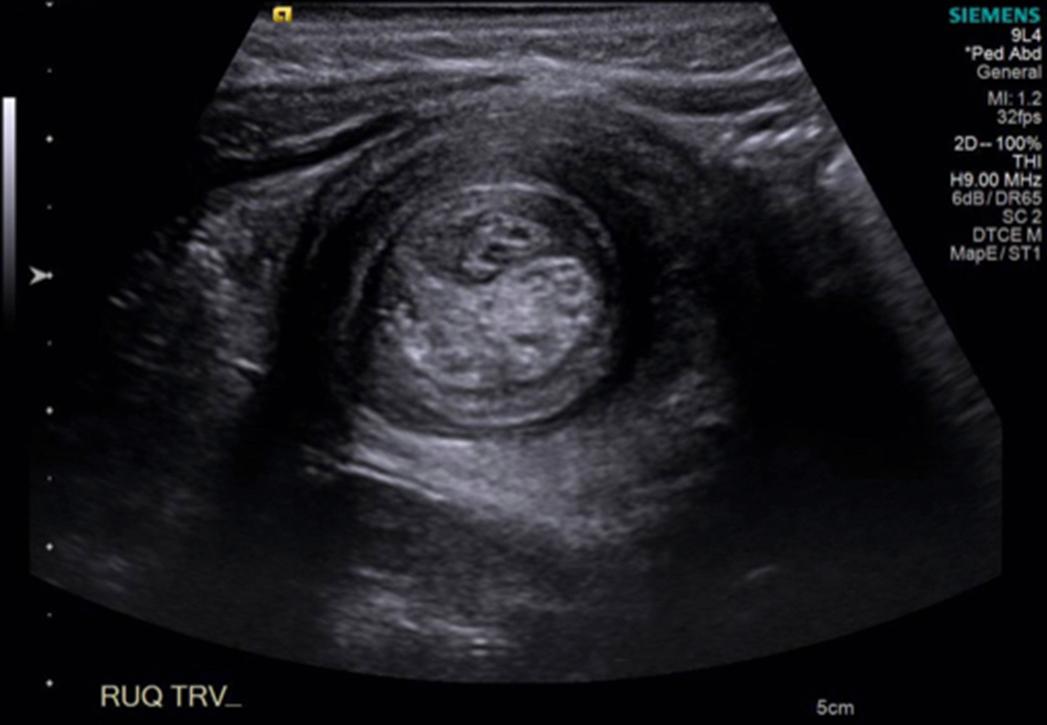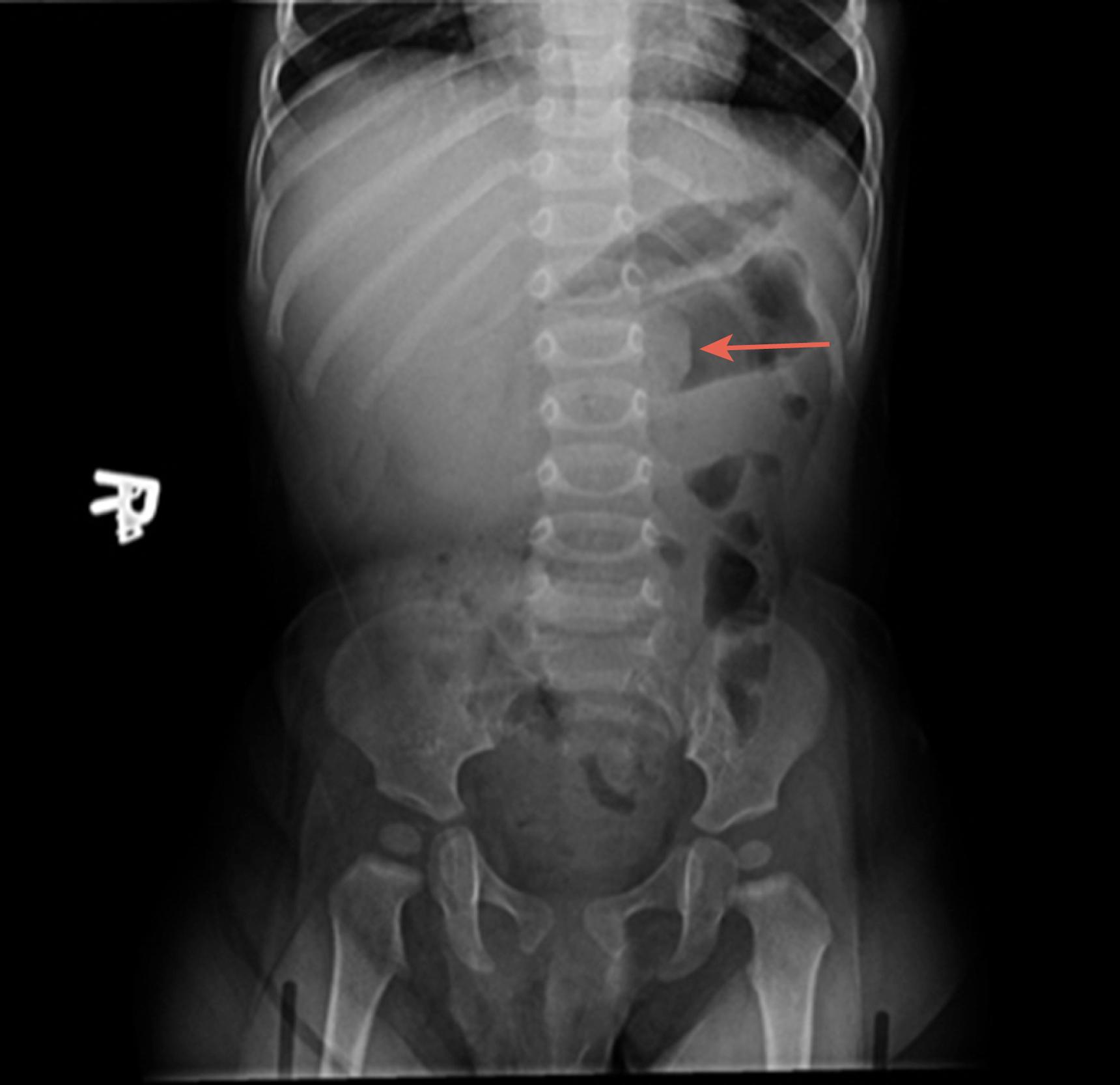Physical Address
304 North Cardinal St.
Dorchester Center, MA 02124
The authors would like to acknowledge the previous authors Anthony T. Manning and Danny C. Little for their assistance with the 6th edition of this chapter.
Intussusception is the most common cause of intestinal obstruction in children less than 2 years of age. Intussusception is defined as the invagination of a segment of intestine into the lumen of an adjacent segment of intestine that occurs during antegrade peristalsis. The bowel that invaginates into the adjacent bowel is called the intussusceptum and the receiving bowel is called the intussuscipiens. Intussusception may occur in any portion of the bowel, with the most common being the ileocolic. Although it was first described in 1674 by Paul Barbette of Amsterdam, the first successful pneumatic reduction was not performed until 1836 by Samuel Mitchell, and the first successful operative reduction after failed air enema was performed in 1871 by Sir Jonathan Hutchinson. It is a surgical emergency, and delay in diagnosis may lead to complete obstruction and vascular compromise resulting in possible necrosis and perforation.
Although intussusception may occur at any age, it most commonly occurs in children between the ages of 3 months to 3 years, with the highest incidence in the first 2 years of life and the peak incidence between 5 and 9 months of age. It is the second most common cause of bowel obstruction in infants, second to pyloric stenosis, and is the most common abdominal emergency in children under the age of 3 years. The incidence varies from 0.24 to 2.4 per 1000 live births, and up to two thirds of the patients are male. The majority of these patients are healthy and well nourished. Although uncommon, intussusception has also been reported in premature infants as well as in utero, which may potentially lead to small bowel atresia.
As described earlier, intussusception occurs when a segment of bowel invaginates into an adjacent segment of intestine. Intussusception most commonly occurs in the antegrade fashion, meaning a proximal segment of bowel invaginates into a distal segment of bowel during peristalsis. Intussusception may occur anywhere in the gastrointestinal (GI) tract, such as small bowel–small bowel (jejuno-jejunal, jejunal-ileal, ileo-ileal) or colocolic, but ileocolic is the most common, occurring in up to 90% of intussusceptions. Once the bowel invaginates into another segment, it causes vascular compromise secondary to venous obstruction, leading to bowel wall edema. This will eventually progress to arterial insufficiency and subsequent ischemia, necrosis, and perforation.
Intussusception may be described as primary or secondary. Primary intussusception, or idiopathic, occurs without a pathologic lead point. These are the majority of cases and occur secondary to lymphoid hyperplasia (hypertrophied Peyer patches) within the bowel wall. The lymphoid hyperplasia is thought to occur secondary to viral infections, such as upper respiratory infections and gastroenteritis. Adenovirus and rotavirus are most commonly implicated, especially since there is an increased incidence of intussusception during seasonal respiratory viral illnesses. Rotavirus vaccination has been linked with increased incidence of intussusception, and the current recommendation is to vaccinate before the peak age of intussusception (prior to 3 months of age).
Secondary intussusception occurs secondary to a pathologic lead point, which has an incidence described anywhere from 1.5% to 12%, and the incidence increases with age. The most common pathologic lead point is an inverted Meckel diverticulum, but may also occur secondary to an intestinal polyp (such as from Peutz-Jeghers syndrome), duplication cyst, lymphoma, or systemic diseases that affect intestinal motility and cause intestinal wall thickening, such as Henoch-Schönlein purpura (HSP), cystic fibrosis, celiac disease, and even Clostridium difficile . It may also occur secondary to foreign objects, such as a gastrojejunal tube.
The classic presentation of intussusception is colicky abdominal pain, palpable abdominal mass, and red currant jelly stools; however, this occurs in less than 25% of children. Emesis also commonly occurs in about 89% of these children, particularly in children less than 1 year of age, and a palpable abdominal mass occurs in about 65%. If a patient presents with abdominal pain, emesis, and a palpable mass in the right upper abdomen, the positive predictive value is about 93%, and this increases to almost 100% if rectal bleeding is also present. ,
Abdominal pain is the most common complaint in all children. The abdominal pain classically occurs as intermittent abdominal pain occurring every 10 to 20 minutes and lasts for a few minutes at a time. The patient often draws the legs to the chest and is inconsolable, and in between episodes, the child is calm and pain free; however, some parents note altered mental status in the patient in between the abdominal pain episodes. Up to 17% of patients will have significant neurological symptoms, such as lethargy and hypotonia.
The classic red currant jelly stools occur secondary to secretion of mucus and bleeding from the congested and edematous bowel. Patients may also have a palpable abdominal mass that is often described as sausage-shaped and is felt in the right upper abdomen in the majority of ileocolic intussusceptions. However, the intussusceptum may extend into the large bowel and present as a rectal mass, which can be differentiated from a rectal prolapse by evaluating for a sulcus between the anus and the mass. If emesis occurs, it usually starts as nonbilious and progresses to bilious. If the patient has abdominal distention with peritonitis, then bowel perforation should be considered.
Given the risk of acute bowel ischemia, intussusception is an abdominal emergency in the pediatric population. It is important to diagnose this early, as there is an increase in risk of surgical intervention when diagnosis is delayed.
The most commonly used imaging modality for diagnosis is an ultrasound. When it is used by an experienced ultrasonographer, it has a greater than 90% sensitivity and specificity. The ultrasound usually shows the characteristic “target sign,” which is the intussusception seen on transverse section and the “pseudo kidney sign” on longitudinal section ( Fig. 51.1 ). Pathologic lead points are often missed on ultrasound.

The gold standard for intussusception diagnosis is contrast enema using fluoroscopy, but given the high accuracy of ultrasound, contrast enema is usually not done unless the ultrasound is inconclusive. Computed tomography (CT) and magnetic resonance imaging (MRI) are also available imaging modalities, but these are unnecessary in the acute setting given the widespread availability of ultrasound.
Although abdominal x-ray is unable to diagnose intussusception, it should be considered as the initial imaging modality in patients to evaluate for bowel obstruction and rule out signs of perforation. A soft tissue mass may be seen on abdominal x-ray, and sometimes the tip of the intussusceptum is outlined by a gas shadow showing a crescent-shaped lucency called the meniscus sign ( Fig. 51.2 ).

Become a Clinical Tree membership for Full access and enjoy Unlimited articles
If you are a member. Log in here